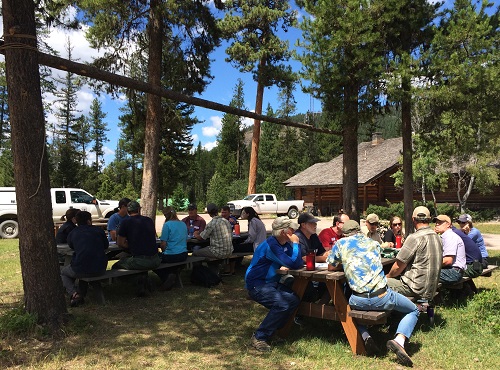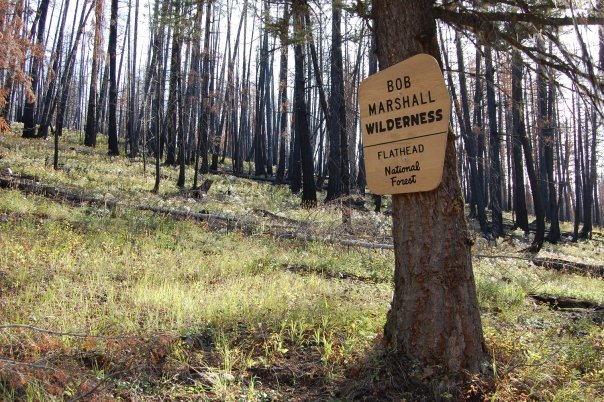The 2016 wilderness fire workshop and field trips provided an opportunity for past, current, and future wilderness fire champions of fire management to discuss challenges and successes. Line officers, fire managers, wilderness managers, researchers, and others interested in wilderness fire management celebrated the legacy of wilderness fire in the Bob Marshall Wilderness Complex and the Northern Rockies by attending a 3-day backcountry field trip, half-day front country field trip, and/or a full-day workshop.
The Northern Rockies Fire Science Network partnered with the Bob Marshall Wilderness Complex Managers and Spotted Bear Ranger District, Flathead National Forest to host these events. Thank you to the Aldo Leopold Wilderness Research Institute and High Plains Films for recording the workshop presentations.
Workshop presentations and short re-caps of the backcountry and frontcountry field trips can be viewed on this page in video and pdf formats. Workshop presentations follow the workshop agenda.
Workshop welcome
Workshop attendees were welcomed to the Spotted Bear Ranger District by Deb Mucklow, District Ranger, Spotted Bear RD and Vita Wright, Principal Investigator, Northern Rockies Fire Science Network. They delivered workshop objectives and an overview of the agenda, which are available via video (3:47 min). Seth Carbonari, District Fire Management Officer (FMO), and Rick Connell, Forest FMO, both from the Flathead NF also discussed objectives for the workshop, which are available via video (1:36 min). Discussion group objectives and desired outcomes for a national group of fire ecology students were also captured via video (0:54 min).
Fieldtrip reports
Backcountry field trip highlights from Seth Carbonari about the effects of multiple fire entries and building support for wilderness fire from the public and neighboring land owners (1:08 min).
Report on the frontcountry field trip to areas burned by the 2015 Bear Creek fire. The report from Matt Counts, Engine Forman, Spotted Bear RD, includes discussion about the logistics and challenges of managing the fire and communication and education during and after the fire, and the differences between managing fire and "letting it burn" (4:36 min).
Recorded Presentations
*All recorded presentations are available in the Recordings section.
History and Evolution of the Wilderness Fire Program in the Bob Marshall Wilderness Complex
Historical Highlights (Dave Bunnell, Retired National Fire Use Program Manager, USFS; George Weldon, Retired Deputy Fire Director, USFS Northern Region)
Recent Highlights (Deb Mucklow, Spotted Bear District Ranger, Flathead National Forest; Mike Munoz, Rocky Mountain District Ranger, Lewis & Clark National Forest)
Wilderness Fire Science (Carol Miller, Aldo Leopold Wilderness Research Institute)
Restoring Forest Structure and Fire Regimes in the Bob (Andrew Larson, University of Montana)
Fire and Climate Relationships in the Northern Rockies (Phil Higuera, University of Montana)
Wildland Fire: Nature’s Fuel Treatment (Sean Parks, Aldo Leopold Wilderness Research Institute)
Non-Recorded Presentation
The national perspective on wilderness and long-duration fire
Frankie Romero, USFS National Fire Use & Fuels Management Specialist, highlights how wilderness fire management has changed national fire management in philosophical, technological, and operational ways. Download presentations slides.
Workshop discussion
1. Was managing wilderness fire harder in the 70s, 80s, 90s or is it harder now? What were the challenges back then, and how did we overcome them?
2. What are the current challenges to managing wilderness fire? How are we overcoming them? What's working well?
3. How might future challenges be different than those of today? How can we build on current successes? How can we perpetuate the legacy and keep fire in wilderness ecosystems?
4. How can research help? What questions do we most need scientists to address to support successful wilderness fire management?

Related Wilderness Fire Events
Related Documents from the Research and Publications Database
Recording(s)
Event Details
Jul 11 - 14 2016, All day
Contact(s)
Vita Wright
PI, Northern Rockies Fire Science Network
Jim Flint
FMO, Spotted Bear RD
Rick Connell
Forest FMO, Flathead NF
